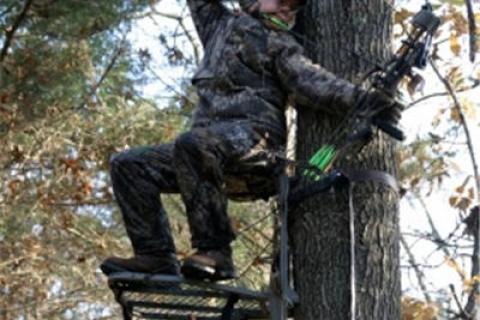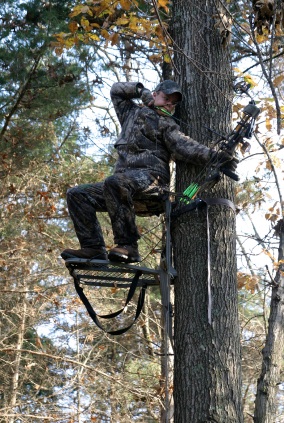
 A climbing treestand can be an extremely helpful piece of gear to have during deer season, as one provides a hunter with improved visibility and a strong vantage point. Plus, climbing treestands are incredibly mobile, allowing for hunters to move easily from site to site. As long as you can find a tree big enough to climb, you can hunt with a climbing treestand just about anywhere you want.
A climbing treestand can be an extremely helpful piece of gear to have during deer season, as one provides a hunter with improved visibility and a strong vantage point. Plus, climbing treestands are incredibly mobile, allowing for hunters to move easily from site to site. As long as you can find a tree big enough to climb, you can hunt with a climbing treestand just about anywhere you want.
If you’re shopping for a new climbing stand, there are many things for you to consider, such as comfort, price point, user-friendliness and more.
To make things go a bit smoothly in your buying process, we’ve compiled a list of things to think about when purchasing a climbing treestand. What works for one hunter won’t necessarily work for another, so think about which treestand characteristics are most important for you. Keep these features in mind:
- User-Friendly -- Many treestands now include instructional DVDs that review assembly instructions and safety guidelines, which can be of great help to those unfamiliar with the piece of equipment. For many, a treestand that comes with this feature may be preferential to one accompanied by confusing assembly diagrams.
- Design Features -- The type of hunting you’re doing will help you determine which design features you’ll need. If you’re bowhunting, you may want a climbing stand with no rail (or one with a flip-up rail) so it doesn’t interfere with your bow’s limbs when drawing and releasing. Firearm/crossbow hunters might prefer a stand with a shooting rail, so you’ve got something to rest the stock on while waiting—and to steady your aim when the critical moment arrives.
- Light -- Different treestands can vary in weight by a wide margin. Typically, lighter ones cost more; however, lighter ones could also lack the bells and whistles you want. Be sure to take a close look at the specs.
Additionally, how far will you typically need to lug your treestand through the woods? You’ll need to take this into account when determining how much treestand weight you can afford to carry.
- Compact -- Even the lightest of treestands can be difficult to transport if they’re awkward and cumbersome. Check into how easy a treestand is to carry before purchasing.
- Quiet -- The convenience of a climber isn’t worth it if it’s so noisy that it scares away all the game. Look for a treestand that you can assemble as soundlessly as possible.
- Comfortable -- For some, it’s just fine if your climber makes you feel like you’re perched on a two-by-four. But for others, a climber isn’t worth having unless the comfort rivals that of a La-Z-Boy. Make sure the comfort level of your climber fits your needs.
- Safe -- For years and years, climbing treestands were often associated with near-death experiences. Now, there are ones on the market that are safe as can be. Pay careful attention to the safety features and limitations of the stand you’re looking at, including harnesses, fall arrest systems and weight limits. Make sure your new purchase makes the cut when it comes to safety.
Also, be sure to follow these treestand safety tips:
1. ALWAYS REMEMBER SAFETY FIRST!
2. ALWAYS wear a TMA approved harness when above ground level.
3. ALWAYS READ and FOLLOW manufacturer's directions.
4. ALWAYS use a rope to raise and lower your weapon and equipment.
5. ALWAYS have your weapon unloaded until you and your treestand are securely in place and you are ready to hunt.
6. ALWAYS check for loose, worn or deteriorating parts before using your stand. Use only manufacturer replacement parts.
7. ALWAYS try your treestand at ground level before you risk a higher position.
8. ALWAYS use extra caution under wet/icy or in dark/low-light conditions.
9. NEVER hunt from a treestand if sick or using medications.
10. NEVER drink alcohol before or during use.
- Good Value -- Budgets can vary widely when it comes to how much a hunter can invest in a treestand. Do your homework to make sure your treestand is a good buy for what you’re spending. Remember that the most expensive isn’t always the best, and that sometimes it’s worth paying a little extra if the product will last for years and years.
In addition to these tips, you can read reviews of treestands you’re considering, check out buyer feedback on message boards and get advice from your fellow hunters. There are several types of treestands available on the market, so do your research to find one that is right for you and your style of hunting. Click the following link to read consumer reviews of the several types of treestands available.
There are also a wide variety of treestand accessories available on the market to help customize your climbing treestand experience.
And remember, SAFETY FIRST! While the other features of your climber are important, the safety features should be the priority. Your life depends on the climber’s flawless performance.
- 6154 views

